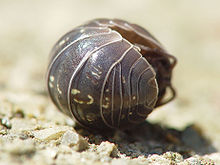- Armadillidium vulgare
-
Armadillidium vulgare 
Scientific classification Kingdom: Animalia Phylum: Arthropoda Subphylum: Crustacea Class: Malacostraca Order: Isopoda Suborder: Oniscidea Family: Armadillidiidae Genus: Armadillidium Species: A. vulgare Binomial name Armadillidium vulgare
Latreille, 1804 [1]Synonyms [2] - Armadillidium affine
- Armadillidium armeniense
- Armadillidium brevicaudatum
- Armadillidium commutatum
- Armadillidium decipiens
- Armadillidium marmoreum
- Armadillidium nitidulum
- Armadillidium oliveti
- Armadillidium pilulare
- Armadillidium schellenbergi
- Armadillidium sorattinum
- Armadillidium subdentatum
- Armadillidium triviale
- Armadillidium variegatum
- Armadillo ater
- Armadillo convexus
- Armadillo marmoreus
- Armadillo pilularis
- Armadillo pustulatus
- Armadillo trivialis
- Armadillo variegatus
- Armadillo vulgaris
Armadillidium vulgare, the (common) pill-bug or (common) pill woodlouse, is a widespread European species of woodlouse. It is the most extensively investigated terrestrial isopod species.[2]
Contents
Description
Armadillidium vulgare may reach a length of 18 millimetres (0.71 in), and is capable of rolling into a ball when disturbed; this ability, along with its general appearance, gives it the name pill-bug and also creates the potential for confusion with pill millipedes such as Glomeris marginata.[3] It can be distinguished from Armadillidium nasatum and Armadillidium depressum, the only other British species in the genus, by the gap that A. nasatum and A. depressum leave when rolling into a ball; A. vulgare does not leave such a gap.[4]
Ecology
A. vulgare is able to withstand drier conditions than many other woodlouse species, and is restricted to calcareous soils or coastal areas.[3] It feeds chiefly on decaying plant matter, but also grazes lichens and algae from tree bark and walls.[5]
It is able to regulate its temperature through its behaviour, preferring bright sunshine when temperatures are low, but remaining in shadow when temperatures are high; temperatures below −2 °C (28 °F) or above 36 °C (97 °F) are lethal to it.[6] A. vulgare is less susceptible to cold during the night, and may enter a state of dormancy during the winter in order to survive temperatures which would otherwise be lethal.[6]
Distribution
The native distribution of A. vulgare ranges across Europe, especially in the Mediterranean region .[2] In the United Kingdom, A. vulgare is very common in southern and eastern England, but is more confined to coastal areas in the north.[7] Similarly, in Ireland, A. vulgare is common in the south and east, but rarer in the north and west.[8]
A. vulgare has been introduced to many locations in North America, where it may reach population densities of up to 10,000 individuals per square metre.[9] It is now one of the most abundant invertebrate species in California coastal grassland habitats.[10] It has also been introduced, to a lesser extent, to sites across the world.[2]
Relationships with people
Because of their unusual yet non-threatening appearance, some Armadillidium vulgare are kept as pets in areas throughout the U.S., typically among children. Among adults, they are often seen as unwanted (but essentially harmless) home pests.[11] Keeping a pet pill bug requires a very moist habitat with limited light and lots of decaying plant matter.[12] They can often live up to three years.[11]
See also
- List of woodlice of the British Isles
References
External identifiers for Armadillidium vulgare EOL 1021952 ITIS 93250 NCBI 13347 Also found in: Wikispecies - ^ "Armadillidium vulgare". Integrated Taxonomic Information System. http://www.itis.gov/servlet/SingleRpt/SingleRpt?search_topic=TSN&search_value=93250.
- ^ a b c d Helmut Schmalfuss (2003). "World catalog of terrestrial isopods (Isopoda: Oniscidea) — revised and updated version". Stuttgarter Beiträge zur Naturkunde, Serie A 654: 341 pp. http://www.oniscidea-catalog.naturkundemuseum-bw.de/Cat_terr_isop.pdf.
- ^ a b "Pill woodlouse (Armadillidium vulgare)". ARKive.org. http://www.arkive.org/pill-woodlouse/armadillidium-vulgare/info.html. Retrieved February 13, 2009.
- ^ "Woodlouse Wizard: an identification key". Natural History Museum. http://www.nhm.ac.uk/woodlice/key.html. Retrieved November 7, 2010.
- ^ "Common pill woodlouse — Armadillidium vulgare". Natural England. http://www.plantpress.com/wildlife/o109-commonpillwoodlouse.php. Retrieved February 13, 2009.
- ^ a b Roberto Refinetti (1984). "Behavioral temperature regulation in the pill bug, Armadillidium vulgare (Isopoda)". Crustaceana 47 (1): 29–43. doi:10.1163/156854084X00298. http://www.ingentaconnect.com/content/brill/cr/1984/00000047/00000001/art00003.
- ^ "Armadillidium vulgare". Natural History Museum. http://www.nhm.ac.uk/woodlice/results/old/armadillidium_vulgare.html. Retrieved November 7, 2010.
- ^ "Grid map of records on the Gateway for Common Pill Woodlouse (Armadillidium vulgare)". NBN Gateway. http://data.nbn.org.uk/gridMap/gridMap.jsp?allDs=1&srchSpKey=NBNSYS0000008572. Retrieved February 13, 2009.
- ^ Jan Frouza, Richard Lobinske, Jirí Kalcík & Arshad Ali (2008). "Effects of the exotic crustacean, Armadillidium vulgare (Isopoda), and other macrofauna on organic matter dynamics in soil microcosms in a hardwood forest in central Florida". Florida Entomologist 91 (2): 328–331. doi:10.1653/0015-4040(2008)91[328:EOTECA]2.0.CO;2. http://www.bioone.org/doi/abs/10.1653/0015-4040(2008)91%5B328:EOTECA%5D2.0.CO%3B2.
- ^ Oscar H. Paris (1963). "The ecology of Armadillidium vulgare (Isopoda: Oniscoidea) in California grassland: food, enemies, and weather". Ecological Monographs (Ecological Society of America) 33 (1): 1–22. doi:10.2307/1948475. JSTOR 1948475.
- ^ a b Smith-Rogers, Sheryl (October 2009). "Wild Thing: Roly-Poly Pillbugs". TPW Magazine. http://www.tpwmagazine.com/archive/2009/oct/scout3/. Retrieved July 10, 2010.
- ^ Stanley A. Schultz & Marguerite J. Schultz (2009). The Tarantula Keeper's Guide: Comprehensive Information on Care, Housing, and Feeding. Barron's Educational Series. pp. 181–183. ISBN 9780764138850.
Categories:- Woodlice
- Woodlice of Europe
- Animals described in 1804
Wikimedia Foundation. 2010.

